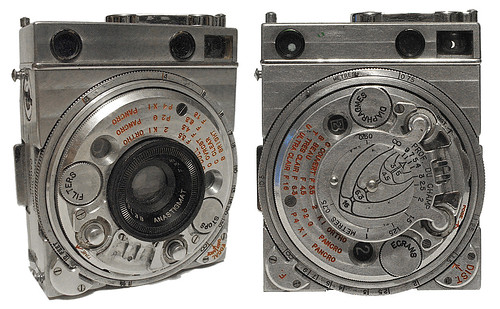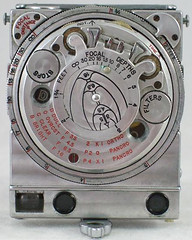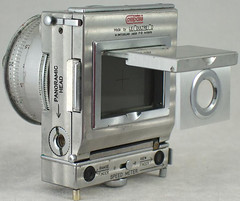Difference between revisions of "Compass"
(image added) |
(designer) |
||
| Line 8: | Line 8: | ||
The '''Compass Camera''' was made by watch-makers Le Coultre et Cie in Switzerland, in c.1937 for London firm Compass Cameras. | The '''Compass Camera''' was made by watch-makers Le Coultre et Cie in Switzerland, in c.1937 for London firm Compass Cameras. | ||
It was a rectangular aluminium-bodied [[rangefinder camera]], made for 24x36mm exposures on plates. | It was a rectangular aluminium-bodied [[rangefinder camera]], made for 24x36mm exposures on plates. | ||
| − | With the lens closed, it was only 30 × 53 × 70mm in size. | + | With the lens closed, it was only 30 × 53 × 70mm (1¼x2<sup>1</sup>/<sub>8</sub>x2¾in) in size, weighing 220g (7¾oz). |
There was a back available for special 8-exposure films, and later also | There was a back available for special 8-exposure films, and later also | ||
an [[828 film|828 roll film]] back, made by | an [[828 film|828 roll film]] back, made by | ||
| − | T. A. Cubitt. About 5000 were made before production was prevented by war.<ref>Coe, Brian, ''"Cameras, from Daguerreotypes to Instant Pictures"'', p.128, Marshall-Cavendish/Nordbok 1978; Coe's drawing shows an example labelled in German; from casual observation, this seems to be unusual, and most are in English, but [http://www.submin.com/large/collection/compass/index.htm submin.com] shows German and French, as well as the majority English models.</ref> | + | T. A. Cubitt. About 5000 were made before production was prevented by war.<ref>Coe, Brian, ''"Cameras, from Daguerreotypes to Instant Pictures"'', p.128, Marshall-Cavendish/Nordbok 1978; Coe's drawing shows an example labelled in German; from casual observation, this seems to be unusual, and most are in English, but [http://www.submin.com/large/collection/compass/index.htm submin.com] shows German and French, as well as the majority English models.</ref> The design was by Noel Pemberton-Billing, an airman and Member of Parliament. There were two versions; the Compass II was offered as a free upgrade to original Compass owners<ref>Auer, Michel, ''The Illustrated History of the Camera, from 1939 to the present'', Fountain Press, 1975</ref>. |
| − | The Compass was extraordinarily well-equipped for such a small package; it had two optical viewfinders, one at a right-angle, a ground glass focusing screen with a folding [[loupe]], a built-in lens cap, three filters, an [[light meter|extinction meter]] and a spirit level. There was also a rotating fitting for the tripod bush in the base with five click stops allowing for panoramic and stereo pictures. | + | The Compass was extraordinarily well-equipped for such a small package; it had two optical viewfinders, one at a right-angle, a ground glass focusing screen with a folding [[loupe]], a built-in lens cap, three filters, an [[light meter|extinction meter]] and a spirit level. There was also a rotating fitting for the tripod bush in the base with five click stops allowing for panoramic and stereo pictures. The shutter ran from 4½s-1/500s. |
The retractable lens was a 35mm f3.5 Kern anastigmat; shutter speeds from 4.5secs to 1/500. | The retractable lens was a 35mm f3.5 Kern anastigmat; shutter speeds from 4.5secs to 1/500. | ||
Revision as of 19:53, 19 February 2009

|
| Compass Camera - lens extended By ebayer Old_devil, used by permission.(Image rights) |
The Compass Camera was made by watch-makers Le Coultre et Cie in Switzerland, in c.1937 for London firm Compass Cameras. It was a rectangular aluminium-bodied rangefinder camera, made for 24x36mm exposures on plates. With the lens closed, it was only 30 × 53 × 70mm (1¼x21/8x2¾in) in size, weighing 220g (7¾oz). There was a back available for special 8-exposure films, and later also an 828 roll film back, made by T. A. Cubitt. About 5000 were made before production was prevented by war.[1] The design was by Noel Pemberton-Billing, an airman and Member of Parliament. There were two versions; the Compass II was offered as a free upgrade to original Compass owners[2].
The Compass was extraordinarily well-equipped for such a small package; it had two optical viewfinders, one at a right-angle, a ground glass focusing screen with a folding loupe, a built-in lens cap, three filters, an extinction meter and a spirit level. There was also a rotating fitting for the tripod bush in the base with five click stops allowing for panoramic and stereo pictures. The shutter ran from 4½s-1/500s.
The retractable lens was a 35mm f3.5 Kern anastigmat; shutter speeds from 4.5secs to 1/500.
The Compass was available in a kit, which could include a small, elegant tripod, fitted with a pocket clip, a cable-release, a small leather case or a larger fitted box taking the accessories.
|
|
| ||||||
|
| |||||||
|
Compass Camera - by ebayer Old_devil, used by permission.(Image rights) | ||||||||

|
| Compass by Rick Soloway |
Links / Sources
- Compass camera on submin.com
- Compass on ukcamera.com
- ↑ Coe, Brian, "Cameras, from Daguerreotypes to Instant Pictures", p.128, Marshall-Cavendish/Nordbok 1978; Coe's drawing shows an example labelled in German; from casual observation, this seems to be unusual, and most are in English, but submin.com shows German and French, as well as the majority English models.
- ↑ Auer, Michel, The Illustrated History of the Camera, from 1939 to the present, Fountain Press, 1975




